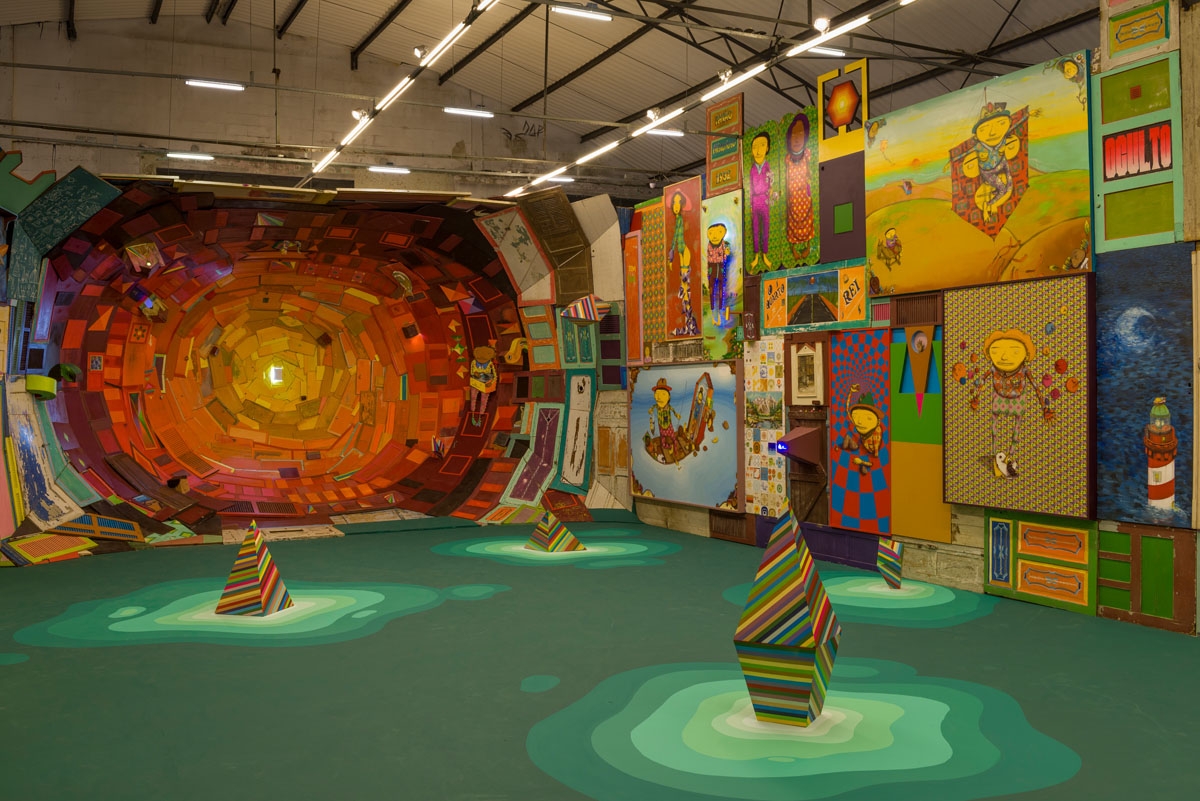Scene of a thousand selfies a day, the latest hometown show by São Paulo’s Os Gêmeos (aka twin brothers Otávio and Gustavo Pandolfo) has gathered such traction in the media, both social and mass, that the out-of-the-way gallery is regularly besieged by queues round the block.
In the first space, not a sliver of wall is left bare. Thirty or so cartoonish paintings are hung as part of an intense immersive installation, interspersed with a riot of colourful doors and wood panels, culminating in a vortex of panels at one end of the room. Crystallike sculptures with multicoloured stripes protrude from the floor, and countless little paintings and small votive shrines are scattered across the walls. These include a mirrored box, which when peered into reflects your face back in the guise of one of Os Gêmeos’s signature characters: a boy with his head swathed in cloth, eyes revealed, but his identity concealed like a ninja or a Black Bloc protester.
What visitors hopefully don’t see looking back at them is the sense of placid, sad-eyed despair in the gaze of the figures in Os Gêmeos’s paintings, the former seeming somehow trapped inside the canvases, looking out impassively with just the hint of an appeal for help behind their deadpan eyes. Because all the BFF Facebook portraits and all the sensual selfies in the world can’t mask the melancholy at the heart of this work.
It’s encapsulated in the worried stares of the yellow-skinned humanoids that populate every painting, and in the oddly joyless technicolour of the dreamworlds that are the subjects of the bulk of the pair’s works. Smart in beautifully patterned shirts and trousers, a cast of lost men and anxious boys are sucked into spinning, hallucinogenic patterns; cast adrift in the dusty sertão (backlands) that underpin the Brazilian folkloric imagery in Os Gêmeos’s art; or encounter vacant, angel-faced goddesses and mermaids in strange, mutating landscapes. That there’s a journey of some kind under way is the most that can be discerned in terms of interpreting the ‘opera’ comprised by the paintings, and it’s into a world of dreams – a journey that’s internalised in an immense zoetropic installation in the second space in the exhibition, in the person of an unidentified giant who pulls open his shirt, and his chest, to reveal a scene inside that sparks into life at sporadic intervals. In it, a naked man springs into a backwards somersault, animated by the strobe-lit spinning of the carousel on which he is fixed, while at his feet, another man rows into the jaws of a blue whale, and behind him a disembodied hand bounces a man’s head like a basketball.
In the third and final space – mocked up as the interior of a tiny one-room house, complete with bed, fridge, sofa, piano – a video installation sets more heads spinning across the wall, and visitors are invited to touch the interactive screen to halt the heads in their tracks before flinging them away in new directions.
‘One of the exhibits is visually disturbing’, says a notice to visitors at the entrance to the show. It refers to the strobe of the zoetrope; but it might just as well be the strained, uneasy expressions on the faces of the characters, and the forlorn, almost nightmarish nostalgia that pervades this absorbing work, even in its lightest moments.
This article originally appeared in the October 2014 issue
